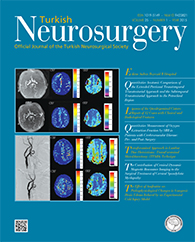2Tepecik Education and Training Hospital, Clinic of Neurosurgery, Izmir, Turkey
3Batman Dunya Hospital, Department of Neurosurgery, Batman, Turkey
4Dicle University, School of Medicine, Department of Neurosurgery, Diyarbakır, Turkey DOI : 10.5137/1019-5149.JTN.9082-13.1 AIM: Cervical spine is the most kinetic segment of the whole vertebrae. The radiologic imaging methods concern with the morphologic changes but give no functional data. At flexion, spinal cord strains, anterior osteophytic compression increases. At extension, spinal canal gets narrower, cord shortens and gets thicker, compression of posterior ligament gets abberant and cord compression increases.
MATERIAL and METHODS: 258 cervical spondylotic myelopathy (CSM) cases were scanned by conventional magnetic resonance imaging (MRI) and additionally dynamic MRI. Contributions of dynamic cervical MRI to the surgical plans and results were evaluated.
RESULTS: We had sagittal and axial T2W MR scans at flexion and extension, in addition to the neutral cervical MR imaging. We found that the AP diameter of spinal canal is increased 14.9 % in flexion and decreased 13.4 % in extension relative to the neutral MR imaging.
CONCLUSION: The changes of the cord compression and the transvers area of cord which is the most important prognostic indicator in spinal diseases and also the area of spinal cord and subarachnoid space can be detected via dynamic axial sections of MRI. Dynamic MR images may be helpfull in the decision making for the surgical treatment of CSM.
Keywords : Cervical, Cervical spondylotic myelopthy, Dynamic, MRI




